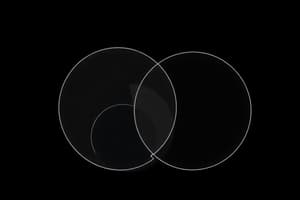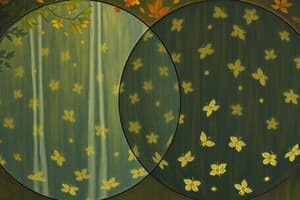Podcast
Questions and Answers
What is a Venn diagram used to represent, and what shape is used to represent the sets?
What is a Venn diagram used to represent, and what shape is used to represent the sets?
A Venn diagram is used to represent sets and their relationships. Overlapping circles are used to represent the sets and their elements.
If A = {1, 2, 3} and B = {2, 3, 4}, what is the difference between A and B, denoted by A - B?
If A = {1, 2, 3} and B = {2, 3, 4}, what is the difference between A and B, denoted by A - B?
A - B = {1}
What is the union of sets A and B, denoted by A ∪ B, if A = {1, 2, 3} and B = {2, 3, 4}?
What is the union of sets A and B, denoted by A ∪ B, if A = {1, 2, 3} and B = {2, 3, 4}?
A ∪ B = {1, 2, 3, 4}
If A = {1, 2, 3} and the universal set U = {1, 2, 3, 4, 5}, what is the complement of A, denoted by A'?
If A = {1, 2, 3} and the universal set U = {1, 2, 3, 4, 5}, what is the complement of A, denoted by A'?
What is the intersection of sets A and B, denoted by A ∩ B, if A = {1, 2, 3} and B = {2, 3, 4}?
What is the intersection of sets A and B, denoted by A ∩ B, if A = {1, 2, 3} and B = {2, 3, 4}?
True or False: A ∪ (B ∩ C) = (A ∪ B) ∩ (A ∪ C).
True or False: A ∪ (B ∩ C) = (A ∪ B) ∩ (A ∪ C).
Flashcards are hidden until you start studying
Study Notes
Venn Diagrams
- A visual representation of sets and their relationships
- Uses overlapping circles to represent sets and their elements
- Can be used to illustrate set operations such as union, intersection, and difference
Set Operations
Difference (A - B)
- Denoted by A - B or A \ B
- The set of elements that are in A but not in B
- Example: If A = {1, 2, 3} and B = {2, 3, 4}, then A - B = {1}
Union (A ∪ B)
- Denoted by A ∪ B
- The set of elements that are in A, in B, or in both
- Example: If A = {1, 2, 3} and B = {2, 3, 4}, then A ∪ B = {1, 2, 3, 4}
Intersection (A ∩ B)
- Denoted by A ∩ B
- The set of elements that are common to both A and B
- Example: If A = {1, 2, 3} and B = {2, 3, 4}, then A ∩ B = {2, 3}
Complement (A')
- Denoted by A' or A^c
- The set of all elements that are not in A
- Example: If A = {1, 2, 3} and the universal set U = {1, 2, 3, 4, 5}, then A' = {4, 5}
Properties of Set Operations
- Commutative Property: A ∪ B = B ∪ A, A ∩ B = B ∩ A
- Associative Property: (A ∪ B) ∪ C = A ∪ (B ∪ C), (A ∩ B) ∩ C = A ∩ (B ∩ C)
- Distributive Property: A ∪ (B ∩ C) = (A ∪ B) ∩ (A ∪ C), A ∩ (B ∪ C) = (A ∩ B) ∪ (A ∩ C)
Venn Diagrams
- Visualize sets and their relationships using overlapping circles
- Each circle represents a set and its elements
Set Operations
Difference
- Finds elements in A but not in B
- Denoted by A - B or A \ B
- Example: A = {1, 2, 3}, B = {2, 3, 4} → A - B = {1}
Union
- Combines elements in A, B, or both
- Denoted by A ∪ B
- Example: A = {1, 2, 3}, B = {2, 3, 4} → A ∪ B = {1, 2, 3, 4}
Intersection
- Finds common elements in A and B
- Denoted by A ∩ B
- Example: A = {1, 2, 3}, B = {2, 3, 4} → A ∩ B = {2, 3}
Complement
- Finds elements not in A
- Denoted by A' or A^c
- Example: A = {1, 2, 3}, U = {1, 2, 3, 4, 5} → A' = {4, 5}
Properties of Set Operations
Commutative Property
- Order of sets does not change the result
- A ∪ B = B ∪ A, A ∩ B = B ∩ A
Associative Property
- Order of operations does not change the result
- (A ∪ B) ∪ C = A ∪ (B ∪ C), (A ∩ B) ∩ C = A ∩ (B ∩ C)
Distributive Property
- Combines union and intersection operations
- A ∪ (B ∩ C) = (A ∪ B) ∩ (A ∪ C), A ∩ (B ∪ C) = (A ∩ B) ∪ (A ∩ C)
Studying That Suits You
Use AI to generate personalized quizzes and flashcards to suit your learning preferences.




